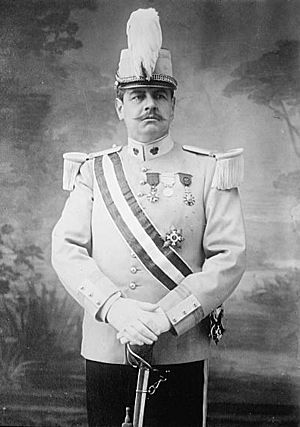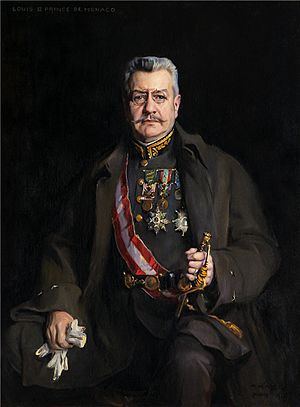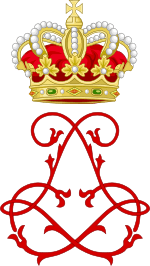Louis II, Prince of Monaco facts for kids
Quick facts for kids Louis II |
|||||
|---|---|---|---|---|---|
 |
|||||
| Prince of Monaco | |||||
| Reign | 26 June 1922 – 9 May 1949 | ||||
| Predecessor | Albert I | ||||
| Successor | Rainier III | ||||
| Born | 12 July 1870 Baden, Grand Duchy of Baden |
||||
| Died | 9 May 1949 (aged 78) Prince's Palace, Monaco |
||||
| Burial | Cathedral of Our Lady Immaculate | ||||
| Spouse | Ghislaine Dommanget | ||||
| Issue | Princess Charlotte, Duchess of Valentinois | ||||
|
|||||
| House | Grimaldi | ||||
| Father | Albert I, Prince of Monaco | ||||
| Mother | Mary Victoria Hamilton | ||||
| Military career | |||||
| Allegiance | |||||
| Service/ |
|||||
| Years of service | 1895-1899 (end of active service) |
||||
| Rank | |||||
Louis II (born Louis Honoré Charles Antoine Grimaldi) was the Prince of Monaco from 1922 to 1949. He was born on July 12, 1870, and passed away on May 9, 1949.
Contents
Early Life and Military Career
Childhood and Family Background
Louis was born in Baden-Baden, Germany. He was the only child of Albert I, Prince of Monaco and Lady Mary Victoria Hamilton. His mother was the daughter of a duke and a princess.
Louis's parents separated shortly after he was born. His mother did not like living in Monaco. Louis was raised in Germany by his mother and stepfather. He did not see his father until he was 11 years old. At that age, he had to return to Monaco to prepare for his future role as prince.
Joining the French Army
Louis's father, Prince Albert I, was a very strong leader. He made Monaco a center for culture and was known worldwide for his smart ideas. Louis did not get along well with his father. As soon as he was old enough, he went to France. He joined Saint-Cyr, which is a famous French military school.
After graduating, Louis joined the French Foreign Legion. He then served with a cavalry regiment in Algeria. While in Paris, he met Marie Juliette Louvet. She was a cabaret singer and already had two children. Louis and Marie Juliette had a daughter named Charlotte Louise Juliette. She was born in Algeria in 1898.
Louis served in the French Army from 1895 to 1899. He reached the rank of lieutenant. He received important awards for his service, including the Colonial Medal and the Cross of the Legion of Honour. When his military service ended, he returned to Monaco.
World War I Service
When World War I began, Louis joined the French Army again as a volunteer. He worked as an officer under General Franchet d’Espèrey. Louis was given the high honor of Grand Officer of the Legion of Honor. He eventually became a Brigadier General.
Solving the Succession Problem
Finding an Heir to the Throne
A big problem arose for Prince Louis. He did not have any other children who could legally inherit the throne. If he died without an heir, the throne of Monaco might go to his German cousin, Wilhelm, the Duke of Urach. Wilhelm was related to Prince Albert's aunt.
To stop this from happening, a law was passed in 1911. This law said that Louis's daughter, Charlotte, could be his official heir. This made her part of the princely family. However, this law was later found to be against older rules from 1882.
So, another law was passed in 1918. This new law allowed an heir to be adopted. In 1919, Charlotte was formally adopted by Louis. She became Charlotte Louise Juliette Grimaldi, Princess of Monaco. She also became the Duchess of Valentinois.
Monaco's Agreement with France
Because of the possible claim by Wilhelm, France and Monaco signed an important treaty in 1918. This treaty said that France had to approve all future princes of Monaco. It also stated that anyone who became prince, whether by marriage or adoption, had to be French or Monegasque. They also needed approval from the French government.
Prince Albert also agreed that Monaco would never be sold or given to any country other than France.
Prince Louis II's Reign
Becoming Prince of Monaco
On June 26, 1922, Prince Albert I passed away. Louis Grimaldi then became the new ruler, known as Louis II, Prince of Monaco. His time as prince might not have been as grand as his father's. However, Louis II still made lasting changes to the small country.
In 1924, the Monaco Football Club was created. In 1929, the first Monaco Grand Prix car race was held. Charles Grover won this race in a Bugatti. Prince Louis also collected items that belonged to Napoleon I. These items are now shown in the Napoleon Museum in Monte Carlo.
Cultural Growth and Challenges
Early in his reign, Prince Louis gained a good reputation for honest management. He removed Camille Blanc, who had managed the Monte Carlo Casino for a long time. There were growing concerns about how Blanc was running the Casino.
In 1931, Monaco's cultural life improved. René Blum was hired to create the "Ballet de l'Opéra à Monte-Carlo." Just before World War II started in 1939, a modern football stadium was built. It was named "Stade Prince Louis II." The Universiade were held there.
Monaco During World War II
Prince Louis strongly supported France. He also supported the French government of Marshal Pétain during World War II. However, Monaco faced problems during the war. This was partly because Louis sometimes struggled to make decisions. Also, many people in Monaco had Italian backgrounds. They supported the Italian government of Benito Mussolini.
In 1942, the Italian Army took control of Monaco. Later, after Mussolini's government fell, the German army occupied Monaco. They began to deport Jewish people. René Blum, who founded the Opera, was among them. He died in Auschwitz, a Nazi concentration camp. Prince Louis secretly ordered the Monaco police to warn people when the Gestapo was coming to arrest them. This was very risky for the police.
During the war, Prince Louis's changing decisions caused a big disagreement with his grandson, Rainier. Rainier was the heir to the throne. He strongly supported the Allies against the Nazis.
After the Allied forces freed Monaco, the 75-year-old Prince Louis did not do much for his country. Monaco began to suffer from neglect. By 1946, he spent most of his time in Paris. On July 24-27, 1946, he married for the first time in Monaco. His wife was Ghislaine Dommanget, a French film actress. For most of his last years as prince, he and his wife lived at their family estate near Paris.
Death and Succession
Prince Louis II passed away in 1949 at the Prince's Palace of Monaco. He is buried at the Saint Nicholas Cathedral in Monte Carlo. His daughter, Hereditary Princess Charlotte, had given up her right to the throne to her son, Rainier, in 1944. At that time, Rainier became the Hereditary Prince. So, when Louis died five years later, his grandson, Prince Rainier III, became the new ruler.
Louis's wife, Ghislaine, Dowager Princess of Monaco, died in 1991 in Paris.
Titles and Honours
 Monaco: Sovereign of the Order of Saint-Charles
Monaco: Sovereign of the Order of Saint-Charles France:
France:
- Grand Cross of the Legion of Honour
- Medal of the Order of the Francisque
- Badge of the Brigadier General
- Badge of the French Foreign Legion
 Baden: Grand Cross of the Military Merit Order of Karl-Friedrich
Baden: Grand Cross of the Military Merit Order of Karl-Friedrich Denmark: Knight of the Order of the Elephant, 23 March 1929
Denmark: Knight of the Order of the Elephant, 23 March 1929- Italy:
 Kingdom of Italy:
Kingdom of Italy:
- Knight with Collar of the Supreme Order of the Most Holy Annunciation
- Grand Cross of the Order of Saints Maurice and Lazarus
 Italian Republic: Grand Cross of the Order of Merit of the Italian Republic
Italian Republic: Grand Cross of the Order of Merit of the Italian Republic
 Holy See: Knight of the Order of Pius IX
Holy See: Knight of the Order of Pius IX Portugal: 298th Grand Cross of the Order of Prince Henry
Portugal: 298th Grand Cross of the Order of Prince Henry San Marino: Grand Cross of the Order of San Marino, 30 March 1935
San Marino: Grand Cross of the Order of San Marino, 30 March 1935 Sweden:
Sweden:
- Commander Grand Cross of the Order of the Polar Star, 1906
- Knight of the Order of the Seraphim, 9 April 1923
 Württemberg: Grand Cross of the Order of the Württemberg Crown, 1889
Württemberg: Grand Cross of the Order of the Württemberg Crown, 1889
Images for kids
See also
 In Spanish: Luis II de Mónaco para niños
In Spanish: Luis II de Mónaco para niños






